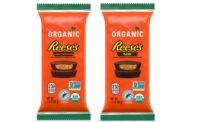The global cocoa and chocolate market is projected to reach $67.22 billion by the end of 2025, up from the $43.13 billion it was at in 2017. The increase represents a compound annual growth rate of 5.7 percent in the forecast period.
That’s according to Trusted Business Insights' "Latest Study on Cocoa and Chocolate Market 2019-2029" report, which has been updated to include the Cocoa and Chocolate Market with business impact analysis and disruption caused by COVID-19.
And it’s the chocolate confectionery sector driving a lot of that demand.
Emerging economies such as China and India have witnessed an exceptional growth trajectory in recent years, attributed to rising consumer expenditure on indulgent confectionery products, especially chocolate confectionery.
On the other hand, there is growing demand for premium or specialty chocolate in developed economies such as the U.S., France, Belgium and Germany.
Major industry factors
The global chocolate market is highly consolidated, dominated by large multinational companies thanks to their vertically-integrated business models, huge clientele base, strong brand loyalty and effective distribution network.
The entire market for cocoa and chocolate, encompassing cocoa trading, processing and chocolate manufacturing, has always remained concentrated, but the rate of such consolidation has intensified over the last decade.
Barry Callebaut, Cargill, Inc., and Olam International are the key players responsible for consolidated market structure, according to the report.
In particular, Barry Callebaut AG has remained one of the most active companies in terms of key market developments.
And the company’s Ruby chocolate, launched in September 2017, has played a major role in that. The chocolate is made from the Ruby cocoa bean, possessing intense taste and a characteristic reddish color.
Some of the other major events that have impacted the chocolate sector include:
- In February 2019, Cargill Cocoa and Chocolate added a new cocoa powder, Gerkens CT70, to its Gerkens cocoa powder brand portfolio.
- In May 2019, Barry Callebaut debuted ruby artisanal pink chocolate made from pure cocoa beans, also known as the fourth type of chocolate in the United States and Canada.
- In June 2019, AAK, an oils and fats supplier, launched COBAO Pure, a new cocoa butter product that delivers bloom-retarding effects in chocolate.
Sustainability
Environmental consciousness is an interesting factor that can guarantee the long-term resilient growth of the cocoa and chocolate industry.
Adoption of Fairtrade practices by cocoa farmers in order to improve cocoa productivity can reduce supply-demand disruption.
Demand for Fairtrade chocolates is expected to grow during the foreseeable period, owing to its sustainability quotient.
Compound chocolate
There’s also expected to be increased demand for cocoa powder, as more companies use compound chocolate.
“The robust trend of healthy snacking is accompanied by growing demand for premium and indulgent offerings with chocolate flavor as most sought after one,” the report says. “This trend has amplified the global sales of cocoa powder which has now emerged as a versatile ingredient in processed foods.”
Couverture or industrial chocolate with high cocoa content is increasingly perceived as a healthy indulgence in the global marketplace. This trend is fueling demand in the industrial chocolate market.
According to the cocoa and chocolate market report, the ongoing inclination toward high cocoa content is responsible for the surge in the sales growth of dark chocolate. This factor will, in turn, stimulate global cocoa and chocolate market growth during the forecast period.
In terms of application, chocolate confectionery is a clear leader within the food processing sector in terms of overall cocoa and chocolate consumption. Nonetheless, the bakery industry is emerging as a lucrative application sector amid the growing popularity of artisanal baked commodities. Cocoa ingredients are now increasingly utilized for premium and indulgent bakery products due to its appealing organoleptic characteristics.
Regional analysis
North America and Europe have traditionally remained as dominating regions for the cocoa and chocolate market. The large cocoa processing base present in these two regions are the key driving force for their market dominance.
The global market of cocoa and chocolate has witnessed a transition, more prominent in the last five years with a sales momentum inclining favorably for the developing markets of Asia Pacific, and the Middle East and Africa.
The per capita consumption of chocolate products remains tepid, but it is largely untapped given the promising potential for indulgent processed offerings and improvements in the discretionary spending patterns.
The cocoa and chocolate market in Asia Pacific is primarily responsible for boosting the cocoa and chocolate sales, therefore exhibiting a CAGR of 8.13 percent from 2018-2025.








